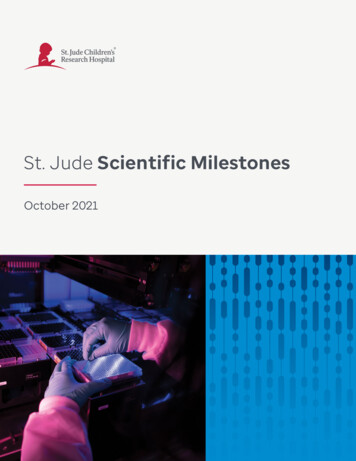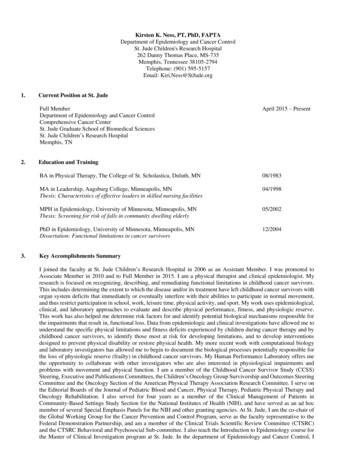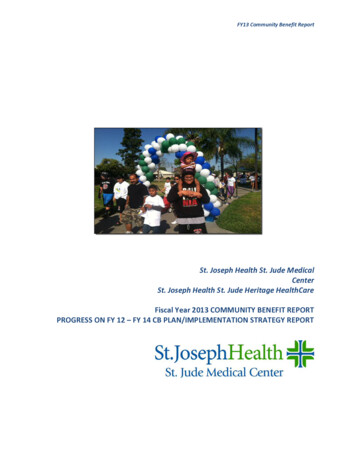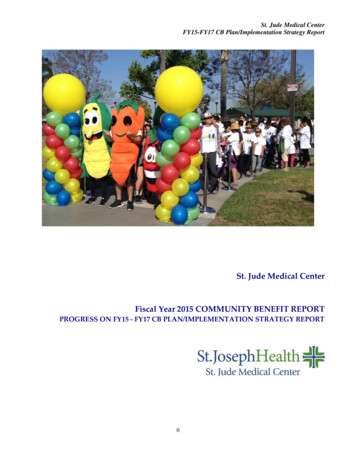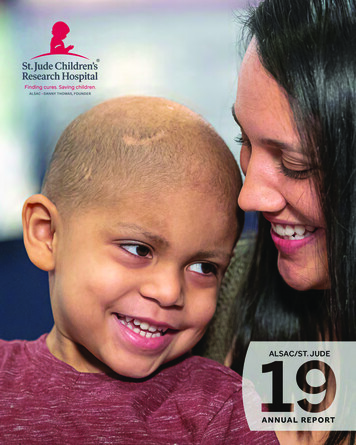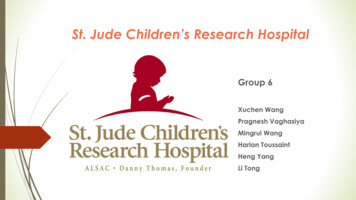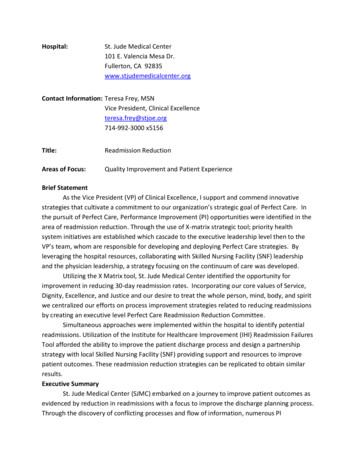
Transcription
Hospital:St. Jude Medical Center101 E. Valencia Mesa Dr.Fullerton, CA 92835www.stjudemedicalcenter.orgContact Information: Teresa Frey, MSNVice President, Clinical Excellenceteresa.frey@stjoe.org714-992-3000 x5156Title:Readmission ReductionAreas of Focus:Quality Improvement and Patient ExperienceBrief StatementAs the Vice President (VP) of Clinical Excellence, I support and commend innovativestrategies that cultivate a commitment to our organization’s strategic goal of Perfect Care. Inthe pursuit of Perfect Care, Performance Improvement (PI) opportunities were identified in thearea of readmission reduction. Through the use of X-matrix strategic tool; priority healthsystem initiatives are established which cascade to the executive leadership level then to theVP’s team, whom are responsible for developing and deploying Perfect Care strategies. Byleveraging the hospital resources, collaborating with Skilled Nursing Facility (SNF) leadershipand the physician leadership, a strategy focusing on the continuum of care was developed.Utilizing the X Matrix tool, St. Jude Medical Center identified the opportunity forimprovement in reducing 30-day readmission rates. Incorporating our core values of Service,Dignity, Excellence, and Justice and our desire to treat the whole person, mind, body, and spiritwe centralized our efforts on process improvement strategies related to reducing readmissionsby creating an executive level Perfect Care Readmission Reduction Committee.Simultaneous approaches were implemented within the hospital to identify potentialreadmissions. Utilization of the Institute for Healthcare Improvement (IHI) Readmission FailuresTool afforded the ability to improve the patient discharge process and design a partnershipstrategy with local Skilled Nursing Facility (SNF) providing support and resources to improvepatient outcomes. These readmission reduction strategies can be replicated to obtain similarresults.Executive SummarySt. Jude Medical Center (SJMC) embarked on a journey to improve patient outcomes asevidenced by reduction in readmissions with a focus to improve the discharge planning process.Through the discovery of conflicting processes and flow of information, numerous PI
opportunities were identified. The formation of a Readmission Reduction Committee structure,inclusive of executive leadership, all frontline disciplines, physicians, and contracted SNFpartners, enabled the identification of interventions to reduce readmissions.The commitment of administrative leadership to the strategic goal of readmissionreduction; continues to motivate the committee to make further improvements. The PerfectCare Readmission Reduction Committee has in attendance four executives: CNO, CMO, MedicalDirector of Care Management, and the VP of Clinical Excellence to support the team’s effortsand remove any barriers that are assessed. Interventions that were developed by this teamspan the patients’ admission, transfer, and discharge to the outpatient setting encompassingthe entire continuum of care. Literature searches, attendance at conferences and openness tonew innovative methods to communicate and process information have afforded the teamsuccess and vision to further achieve goals and improve patient outcomes. Refer to Figure 1and 2.Significance:St. Jude Medical Center identified the opportunity to improve 30 day readmissions in FY2011. Through data analysis of all cause readmissions the overall rate was 10.6%, and by ClinicalFocus group populations it was determined that AMI all cause was 15%, Heart Failure all causewas 14% and Pneumonia all cause was 14%. These rates were above national averages andwere identified as areas of opportunity.St Jude Medical Center employs Lean methodology and uses the X-Matrix as a one-pagevisual tool depicting the alignment of our strategic initiatives and measures at multiplelevels. The purpose of the tool is to develop and implement plans that are strategic, tactical,and coordinated across all stakeholders of the organization. It ensures there is ownership at alllevels, encourages organizational learning, faster corrective action, and accountability.The X-Matrix “South Box” contains the organization’s mission, vision, and values alongwith the collective five-year strategic objectives. These objectives are categorized indimensions aimed at addressing areas of opportunity faced in today’s healthcare environment.Currently the categories of focus include: engaged people, information sophistication, value,and network of care, physician partnership, population health, and essentiality. As a cascade,the objectives set forth in the X-Matrix begin at the Health System (level zero), cascade to theSouthern California Region (level one), which cascades to the hospital, St Jude Medical Center(level two). From the hospital level, cascading continues to the Vice-President or Division (levelthree). Some divisions also create an x-matrix for their Directors (level four), while others usethe Vice-President’s x-matrix for goal setting.
The organization’s initiatives and metrics are further cascaded to frontline staff on aroutine basis. This includes the publishing of results for the organization’s strategic goals on amonthly basis for key value metrics (quality, patient experience, and affordability). Thisinformation is in graphical form illustrating current performance and fiscal year-to-date trendcompared to threshold, target, and exceptional benchmarks. This information is posted indepartment visual management display cases where managers are able to discuss and shareoutcome information during team huddles with their staff. For the current fiscal year, ourorganization publishes routine performance outcome measures, including ourObserved/Expected readmission rate (identified populations: AMI, HF, PN, COPD, H&K, CABG).St. Jude Medical Center set targets to reduce overall readmissions using goals staggeredover a three year period. Targets were based on exceeding Top Quartile outcomes from thebaseline period. Using calendar year 2014 as a baseline, target goals were established for eachsuccessive year from FY16 to FY18: FY16 Target (1/3 between baseline and target), FY17 (2/3between baseline and target), FY18 goal of meeting top quartile goal. Top quartiles weredrawn from Premier, a healthcare data alliance warehouse that manages data from over 3,600US hospitals.Innovation:The innovations undertaken were in two specific areas encompassing overall 30-dayreadmission reduction for all payors, with an emphasis on the reduction of readmissions fromskilled nursing facilities (SNFs). Initial work included the formation of a performanceimprovement team where a process flow map was created. The map depicted the number ofco-competing priorities for patients at admission and discharge. The team comprised of all ofthe process stakeholders, including physicians. The goal was to discover the current processesthat were in place in each of the divisions, common duplications between departments, and tostreamline the information to develop consistencies in practice.The outcome of the review was a new design that allowed for improved communicationbetween disciplines, a more focused review of patient needs prior to discharge, as well asidentification of potential readmission triggers. Patients with insurance or social situations thatwould not be supportive of a successful discharge were identified and connected with servicesthat could be integrated into their care, i.e., transportation arrangements, referral andscheduling at the transitional medical clinic, and medication payment assistance.From that initial process map a number of interventions were identified; processchanges that were needed and overall flow of information changes were required. One of theinitial interventions was to produce a list of all readmissions from the previous day which is sentout to the hospitalists, care managers, nursing unit managers, infection prevention, and
pharmacy. The intent of this communication is to trigger conversation at the bedside in theconsideration and development of an alternative discharge plan from the index discharge plan.An executive-level committee with membership from hospital leadership, nursing,pharmacy, care management, medical group care management, ancillary disciplines andnavigators was formed. The Perfect Care Readmission Reduction Steering Committee meetsonce a month to assess the compliance with processes, review all failures in discharge planning,and work on developing immediate action to mitigate any failures identified. This committeeserves as an integrated platform with our outpatient partners. As new and improvedoutpatient programs are created the structure allow for integration across the continuum ofcare.A readmission team was created to review all inpatient readmissions within 30 days.Members include representatives from nursing, dietary, palliative care, respiratory, quality,case management, home health, physician utilization, and a physician champion. This teammeets weekly and analyzes the readmissions using an IHI readmission reason tool that providesthe ability to track possible failures in the discharge process. The IHI tool provides criteria forreview to determine if failures occured. The failures are categorized by patient assessment,patient and family caregiver education, handoff communication, and discharge from hospitalfailures. Based on the aggregate data collected from these reviews, targeted interventions wereput into place. A tracking tool for the interventions was implemented to improve theaccountability of outcomes.The Care Management staff complete an evidenced based readmission assessment onevery patient readmitted from home. The utilization of the IHI evidence based tool allowed theteam to identify potential reasons for avoidable readmissions. The assessment contains a list ofquestions including: medication understanding, availability of the medication, understanding ofthe discharge plans, contacting the physician’s office, appointments at the physician’s office ortransitional Medical Clinic, language barrier issues and overall reason for readmission. Analysisof this data demonstrated that the largest opportunity was with the patient and caregiver’sunrealistic expectation for care at home. This will allow the hospital to refocus efforts for careto the patient and caregiver training. Caregiver Training is being developed to include thepatient and caregiver with hands-on training prior to discharge.The important strategic approach was to include a focus on SNF readmissions and tocreate SNF group from the local area who were willing to partner with the hospital as activeparticipants in readmission reduction. In May 2015 the initial collaborative of SNFs wasconvened with the purpose of building trust among the partners and to focus on patientoutcomes. St. Jude Medical Center collaborated with six local SNFs and provided an avenue forthe SNFs to initiate and discuss improvement of communication during patient handoff and
transfers. Individual SNF meetings were held to review and agree upon the metrics capturedon the SNF dashboard that represented important SNF benchmarks for the hospital.St. Jude Medical Center continued to pursue a stronger collaboration by introducing andincorporating an evidence-based quality improvement program called INTERACT (Interventionsto Reduce Acute Care Transfers). On July 30, 2015, CALTCM (California Association of LongTerm Care Medicine) did a one day training at St. Jude Medical Center with a goal to “Train theTrainers” on the INTERACT tools and processes for daily use at the SNFs. The attendees presentwere physicians, directors of nursing, and directors of staff development, administrators, andhospital representatives. The forum allowed the attendees from each skilled nursing facility toask questions, identify their facility’s skilled capabilities, and develop an individualized skillednursing facility action plan to implement all, or some portions, of the INTERACT program withthe guidance of CALTCM.In conjunction with this process, a St. Jude Medical Center SNF Liaison was hired toprovide oversight of the INTERACT program at the partnered SNFs. In addition, the SNF Liaisonprovides a valuable review of hospital readmissions from the SNF to the weekly Readmissiongroup. The review is focused on what we could have done better from the hospital perspectiveand whether the SNF required added resources to improve processes.The SNF collaborative meetings expanded to include hospital leaders in specific areas ofInfection Prevention, Respiratory Therapy, Wound Care, Orthopedic services and nursing staffworking on Clinical III projects to improve patient outcomes. The focus of these leaders is toprovide the six partnered SNFs with real-time education to mirror hospital processes and shareany newly discovered best practices within their scopes. This is an ongoing effort to reducepatient harm, improve patient safety and quality outcomes.Integration:St. Jude Medical Center has incorporated into the Perfect Care Readmission ReductionSteering Committee the interventions discovered through the performance improvement workfor both inpatient readmission reduction and the SNF Steering committee. This steeringcommittee expanded the focus from inpatient readmissions from home and SNF to include themedical group outpatient case management process, Transitional Medical Care, the CareConnect team, home health, hospice, St. Jude Medical Center palliative care program,outpatient palliative care program, and the nurse advice line. A performance improvementtracker was developed to collect the number of new and current interventions being tested.The tracker is reviewed monthly at the steering committee.The hospital SNF Liaison has afforded the opportunity to obtain much neededinformation at the SNF sites to improve the hospital discharge process. The addition of this role
brings the effect of what the hospital discharge process documentation contains and thecommunication of information to the partnership to reduce the patient from being readmittedto the forefront. This integration of the SNF Liaison into the SNF and Hospital process has led toimprovements in the discharge information that is provided, more concise and better packagedinformation to the SNFs.An analysis was preformed of each of the SNF readmissions with identified potentialinterventions. These identified interventions provided to the SNF partners include: a) theinfection preventionist consultation on hand hygiene that allowed the SNF to identify the needfor increases hand hygiene stations; b) decrease turnaround times for lab test by providing theSNFs with lab draws at the SNF and processing at the hospital; c) heart failure education to theSNF staff to identify exacerbation of Heart Failure; d) early identification of sepsis in the SNFwith beginning treatment; e) a collaborative of SNF physicians performing medical recordreview to identify opportunities.Every day the readmissions from the most recent 30 day period are reviewed by thedata analyst, placed on a list then sent out to the Readmission Core Team to review anddevelop changes in discharge plans. This Core Team consist of front line staff, Care Managersand physicians has daily rounds and develop discharge plans that encompass the patient’sneeds, caregiver education for realistic expectations and once discharged the outpatient staffcalls each patient to ensure the discharge plans are executed. The weekly review of all previousweeks’ readmissions has resulted in changes to interventions, and identification of dischargeprocesses that are not meeting the overall patient needs.The integration of these efforts focused on patient safety. Through the inclusion ofmultiple disciplines: pharmacy, nursing, care management, outpatient services throughphysicians’ offices, outpatient care management and palliative-Hospice care has allowed for arobust developed readmission and discharge process. The focus of doing the “right thing” forpatient safety and not just focusing on the outcome of satisfaction metric allowed the teams tomake needed changes to the discharge process.Results:Strategic focus for Readmission Reduction has been on the clinical areas of HeartFailure, Pneumonia, COPD, AMI, Hip and Knee replacement surgery. In fiscal year 2016, themonthly overall readmission rates met the top quartile goal 5 of the 8 months measured withour fiscal year to date (0.79) at target. SJMC is currently outperforming the FY 2018 top quartileNational Benchmark for Readmission Reduction.Figure 1: Observed/Expected Readmission Ratio
Figure 2: SNF Readmission Rate
Overall results compared to the peer group demonstrate a strong trend of decreasedreadmission. The trends for the SNF Readmission identified special cause variation throughanalysis of individual cases with opportunity in the case mix Severity of Illness (SOI), and Sepsisareas.Sustainability:The readmission review process, committee structure and SNF Liaison role wasdeveloped to support the readmission reduction goals has now been in place for four years. Thecontinuous improvement in the structure allowed new membership with fresh eyes andinnovative ideas to contribute to the readmission reduction effort. In addition, thecommitment of the hospital leadership to the project and dedication of resources elevated andsupported the importance of this work.The evolution of the SNF partnership process 18 months ago has created a generatednew passion by both the partnered SNFs and hospital leadership. The focus on collaborationbetween the two types of facilities has identified the need for knowledge and resources by bothentities. Incorporation of the SNF processes into the Perfect Care Committee added to thesuccess of overall readmission reduction. The grant for the original SNF Liaison role wasextended for another two years as a direct result of the successful partnership and outcomes topatients.Scalability:St. Jude Medical Center has been identified as a best practice for the readmissionreduction process within the St. Joseph Health System. These processes, committee structure,and the work completed by the SNF partnership have been adopted by the other St. JosephHealth hospitals and will continue to be a strategic goal.The value of this endeavor is realized by the support provided by the ExecutiveLeadership team, finance and frontline staff, as well as the Readmission Reductioninterdisciplinary team. The performance improvement activities and overall committeestructure that provides oversight for the development and implementation of the SNFpartnership and hospital readmission goals are linked to the overall hospital strategic goals.Replication of the interventions, accountability structure, discharge planning,readmission identification, and SNF partnership, will support other organizations to achievesimilar results.
Hospital: St. Jude Medical Center 101 E. Valencia Mesa Dr. Fullerton, CA 92835 www.stjudemedicalcenter.org Contact Information: Teresa Frey, MSN Vice President, Clinical Excellence teresa.frey@stjoe.org 714-992-3000 x5156 Title: Readmission Reduction Areas of Focus: Quality Improvement and Patient Experience Brief Statement
